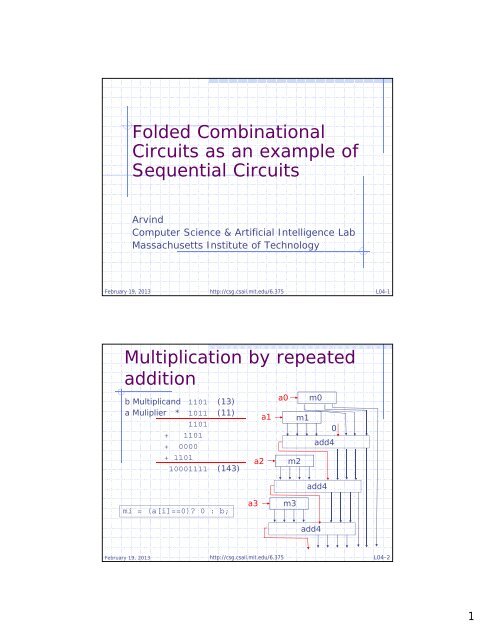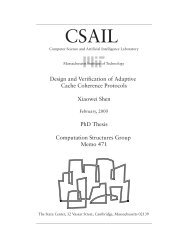Folded Combinational Circuits as an example of Sequential Circuits ...
Folded Combinational Circuits as an example of Sequential Circuits ...
Folded Combinational Circuits as an example of Sequential Circuits ...
Create successful ePaper yourself
Turn your PDF publications into a flip-book with our unique Google optimized e-Paper software.
<strong>Folded</strong> <strong>Combinational</strong><br />
<strong>Circuits</strong> <strong>as</strong> <strong>an</strong> <strong>example</strong> <strong>of</strong><br />
<strong>Sequential</strong> <strong>Circuits</strong><br />
Arvind<br />
Computer Science & Artificial Intelligence Lab<br />
M<strong>as</strong>sachusetts Institute <strong>of</strong> Technology<br />
February 19, 2013 http://csg.csail.mit.edu/6.375 L04-1<br />
Multiplication by repeated<br />
addition<br />
b Multiplic<strong>an</strong>d 1101 (13)<br />
a Muliplier * 1011<br />
1101<br />
(11)<br />
+ 1101<br />
+ 0000<br />
+ 1101<br />
10001111 (143)<br />
mi = (a[i]==0)? 0 : b;<br />
a3<br />
a2<br />
a1<br />
a0<br />
m2<br />
m3<br />
m1<br />
m0<br />
add4<br />
add4<br />
add4<br />
February 19, 2013 http://csg.csail.mit.edu/6.375 L04-2<br />
0<br />
1
<strong>Combinational</strong> 32-bit multiply<br />
function Bit#(64) mul32(Bit#(32) a, Bit#(32) b);<br />
Bit#(32) prod = 0;<br />
Bit#(32) tp = 0;<br />
for(Integer i = 0; i < 32; i = i+1)<br />
begin<br />
let m = (a[i]==0)? 0 : b;<br />
let sum = add32(m,tp,0);<br />
prod[i] = sum[0];<br />
tp = truncateLSB(sum);<br />
end<br />
return {tp,prod};<br />
endfunction<br />
<strong>Combinational</strong><br />
circuit uses 31<br />
add32 circuits<br />
February 19, 2013 http://csg.csail.mit.edu/6.375 L04-3<br />
Design issues with<br />
combinational multiply<br />
Lot <strong>of</strong> hardware<br />
32-bit multiply uses 31 add32 circuits<br />
Long chains <strong>of</strong> gates<br />
32-bit ripple carry adder h<strong>as</strong> a 31-long<br />
chain <strong>of</strong> gates<br />
32-bit multiply h<strong>as</strong> 31 ripple carry adders in<br />
sequence!<br />
The speed <strong>of</strong> a combinational circuit is<br />
determined by its longest input-to-output<br />
path<br />
C<strong>an</strong> we do better?<br />
February 19, 2013 http://csg.csail.mit.edu/6.375 L04-4<br />
2
We c<strong>an</strong> reuse the same add32<br />
circuit if we c<strong>an</strong> store the partial<br />
results in some storage device, e.g.,<br />
register<br />
February 19, 2013 http://csg.csail.mit.edu/6.375 L04-5<br />
<strong>Combinational</strong> circuits<br />
A0 A1 A n-1<br />
A<br />
. ..<br />
lg(n)<br />
Sel<br />
Mux<br />
Decoder<br />
lg(n)<br />
. .<br />
O<br />
O0 O1 O n-1<br />
A<br />
B<br />
A<br />
Sel<br />
Demux<br />
OpSelect<br />
ALU<br />
lg(n)<br />
. .<br />
O0 O1 O n-1<br />
- Add, Sub, ...<br />
- And, Or, Xor, Not, ...<br />
- GT, LT, EQ, Zero, ...<br />
Result<br />
Comp?<br />
Such circuits have no cycles (feedback) or<br />
state elements<br />
February 19, 2013 http://csg.csail.mit.edu/6.375 L04-6<br />
3
A simple synchronous state<br />
element<br />
Edge-Triggered Flip-flop<br />
C<br />
D<br />
Q<br />
D<br />
C<br />
ff<br />
Q<br />
Met<strong>as</strong>tability<br />
Data is sampled at the rising edge <strong>of</strong> the clock<br />
February 19, 2013 http://csg.csail.mit.edu/6.375 L04-7<br />
C<br />
EN<br />
D<br />
Q<br />
Flip-flops with Write Enables<br />
D<br />
C<br />
EN<br />
ff<br />
Data is captured only if EN is on<br />
Q<br />
EN<br />
C<br />
D<br />
C<br />
D<br />
d<strong>an</strong>gerous!<br />
February 19, 2013 http://csg.csail.mit.edu/6.375 L04-8<br />
EN<br />
0<br />
1<br />
ff<br />
ff<br />
Q<br />
Q<br />
4
Registers<br />
En<br />
C<br />
D<br />
ff<br />
Q<br />
D<br />
ff<br />
Q<br />
D<br />
ff<br />
Q<br />
Register: A group <strong>of</strong> flip-flops with a common<br />
clock <strong>an</strong>d enable<br />
D<br />
ff<br />
Q<br />
Register file: A group <strong>of</strong> registers with a common<br />
clock, input <strong>an</strong>d output port(s)<br />
February 19, 2013 http://csg.csail.mit.edu/6.375 L04-9<br />
We c<strong>an</strong> build useful <strong>an</strong>d<br />
compact circuits using<br />
registers<br />
<strong>Circuits</strong> containing state elements<br />
are called sequential circuits<br />
February 19, 2013 http://csg.csail.mit.edu/6.375 L04-10<br />
D<br />
ff<br />
Q<br />
D<br />
ff<br />
Q<br />
D<br />
ff<br />
Q<br />
D<br />
ff<br />
Q<br />
5
Expressing a loop using<br />
registers<br />
int s = s0;<br />
for (int i = 0; i < 32; i = i+1) {<br />
s = f(s);<br />
}<br />
return s; C-code<br />
+1<br />
i<br />
< 32<br />
0<br />
notDone<br />
sel<br />
f<br />
s<br />
s0<br />
sel<br />
We need two registers<br />
to hold s <strong>an</strong>d i values<br />
from one iteration to<br />
the next.<br />
These registers are<br />
initialized when the<br />
computation starts <strong>an</strong>d<br />
updated every cycle<br />
until the computation<br />
terminates<br />
en en<br />
sel = start<br />
en = start | notDone<br />
February 19, 2013 http://csg.csail.mit.edu/6.375 L04-11<br />
Expressing sequential<br />
circuits in BSV<br />
<strong>Sequential</strong> circuits, unlike combinational<br />
circuits, are not expressed structurally (<strong>as</strong><br />
wiring diagrams) in BSV<br />
For sequential circuits a designer defines:<br />
State elements by inst<strong>an</strong>tiating modules<br />
Reg#(Bit#(32)) s
Rule Execution<br />
When a rule executes:<br />
all the registers are read<br />
at the beginning <strong>of</strong> a<br />
clock cycle<br />
the guard <strong>an</strong>d<br />
computations to<br />
evaluate the next value<br />
<strong>of</strong> the registers are<br />
performed<br />
at the end <strong>of</strong> the clock<br />
cycle registers are<br />
updated iff the guard is<br />
true<br />
Muxes are need to<br />
initialize the registers<br />
Reg#(Bit#(32)) s
<strong>Sequential</strong> multiply<br />
Reg#(Bit#(32)) a
Replacing repeated<br />
selections by shifts<br />
Reg#(Bit#(32)) a
Circuit <strong>an</strong>alysis<br />
Number <strong>of</strong> add32 circuits h<strong>as</strong> been reduced<br />
from 31 to one, though some registers <strong>an</strong>d<br />
muxes have been added<br />
The longest combinational path h<strong>as</strong> been<br />
reduced from 31 serial add32’s to one add32<br />
plus a few muxes<br />
The sequential circuit will take 31 clock cycles<br />
to compute <strong>an</strong> <strong>an</strong>swer<br />
February 19, 2013 http://csg.csail.mit.edu/6.375 L04-19<br />
in0<br />
in1<br />
in2<br />
in3<br />
in4<br />
…<br />
in63<br />
<strong>Combinational</strong> IFFT<br />
Bfly4<br />
Bfly4<br />
x16<br />
Bfly4<br />
Permute<br />
Bfly4<br />
Bfly4<br />
…<br />
Bfly4<br />
Bfly4<br />
Bfly4<br />
…<br />
Bfly4<br />
Reuse the same circuit three times<br />
to reduce area<br />
Permute<br />
Permute<br />
out0<br />
out1<br />
out2<br />
out3<br />
out4<br />
…<br />
out63<br />
February 19, 2013 http://csg.csail.mit.edu/6.375 L04-20<br />
10
BSV Code for stage_f<br />
function Vector#(64, Complex#(n)) stage_f<br />
(Bit#(2) stage, Vector#(64, Complex#(n)) stage_in);<br />
Vector#(64, Complex#(n)) stage_temp, stage_out;<br />
for (Integer i = 0; i < 16; i = i + 1)<br />
begin<br />
Integer idx = i * 4;<br />
Vector#(4, Complex#(n)) x;<br />
x[0] = stage_in[idx]; x[1] = stage_in[idx+1];<br />
x[2] = stage_in[idx+2]; x[3] = stage_in[idx+3];<br />
let twid = getTwiddle(stage, fromInteger(i));<br />
let y = bfly4(twid, x);<br />
stage_temp[idx] = y[0]; stage_temp[idx+1] = y[1];<br />
stage_temp[idx+2] = y[2]; stage_temp[idx+3] = y[3];<br />
end<br />
//Permutation<br />
for (Integer i = 0; i < 64; i = i + 1)<br />
twid’s are<br />
stage_out[i] = stage_temp[permute[i]];<br />
mathematically<br />
return(stage_out);<br />
derivable<br />
endfunction<br />
const<strong>an</strong>ts<br />
February 19, 2013 http://csg.csail.mit.edu/6.375 L04-21<br />
Higher-order functions:<br />
Stage functions f1, f2 <strong>an</strong>d f3<br />
function f0(x)= stage_f(0,x);<br />
function f1(x)= stage_f(1,x);<br />
function f2(x)= stage_f(2,x);<br />
What is the type <strong>of</strong> f0(x) ?<br />
function Vector#(64, Complex) f0<br />
(Vector#(64, Complex) x);<br />
February 19, 2013 http://csg.csail.mit.edu/6.375 L04-22<br />
11
<strong>Folded</strong> <strong>Combinational</strong> Ckts<br />
x<br />
inQ<br />
f<br />
stage<br />
sReg<br />
outQ<br />
rule folded-pipeline (True);<br />
let sxIn = ?;<br />
if (stage==0)<br />
begin sxIn= inQ.first(); inQ.deq(); end<br />
else sxIn= sReg;<br />
notice stage<br />
let sxOut = f(stage,sxIn); is a dynamic<br />
if (stage==n-1) outQ.enq(sxOut); parameter<br />
else sReg
Superfolded pipeline<br />
One Bfly-4 c<strong>as</strong>e<br />
f will be invoked for 48 dynamic<br />
values <strong>of</strong> stage<br />
each invocation will modify 4<br />
numbers in sReg<br />
after 16 invocations a permutation<br />
would be done on the whole sReg<br />
February 19, 2013 http://csg.csail.mit.edu/6.375 L04-25<br />
Superfolded IFFT:<br />
stage function f<br />
Bit#(2+4) (stage,i)<br />
function Vector#(64, Complex) stage_f<br />
(Bit#(2) stage, Vector#(64, Complex) stage_in);<br />
Vector#(64, Complex#(n)) stage_temp, stage_out;<br />
for (Integer i = 0; i < 16; i = i + 1)<br />
begin Bit#(2) stage<br />
Integer idx = i * 4;<br />
let twid = getTwiddle(stage, fromInteger(i));<br />
let y = bfly4(twid, stage_in[idx:idx+3]);<br />
stage_temp[idx] = y[0]; stage_temp[idx+1] = y[1];<br />
stage_temp[idx+2] = y[2]; stage_temp[idx+3] = y[3];<br />
end<br />
//Permutation<br />
for (Integer i = 0; i < 64; i = i + 1)<br />
stage_out[i] = stage_temp[permute[i]];<br />
return(stage_out);<br />
endfunction<br />
should be done only when i=15<br />
February 19, 2013 http://csg.csail.mit.edu/6.375 L04-26<br />
13
Code for the Superfolded<br />
stage function<br />
Function Vector#(64, Complex) f<br />
(Bit#(6) stagei, Vector#(64, Complex) stage_in);<br />
let i = stagei `mod` 16;<br />
let twid = getTwiddle(stagei `div` 16, i);<br />
let y = bfly4(twid, stage_in[i:i+3]);<br />
let stage_temp = stage_in;<br />
stage_temp[i] = y[0];<br />
stage_temp[i+1] = y[1];<br />
stage_temp[i+2] = y[2];<br />
stage_temp[i+3] = y[3];<br />
One Bfly-4 c<strong>as</strong>e<br />
let stage_out = stage_temp;<br />
if (i == 15)<br />
for (Integer i = 0; i < 64; i = i + 1)<br />
stage_out[i] = stage_temp[permute[i]];<br />
return(stage_out);<br />
endfunction<br />
February 19, 2013 http://csg.csail.mit.edu/6.375 L04-27<br />
802.11a Tr<strong>an</strong>smitter<br />
[MEMOCODE 2006] Dave, Gerding, Pellauer, Arvind<br />
Design Lines <strong>of</strong> Relative<br />
Block Code (BSV) Area<br />
Controller 49 0%<br />
Scrambler 40 0%<br />
Conv. Encoder 113 0%<br />
Interleaver 76 1%<br />
Mapper 112 11%<br />
IFFT 95 85%<br />
Cyc. Extender 23 3%<br />
Complex arithmetic libraries constitute <strong>an</strong>other 200<br />
lines <strong>of</strong> code<br />
February 19, 2013 http://csg.csail.mit.edu/6.375 L04-28<br />
14
The<br />
same<br />
source<br />
code<br />
802.11a Tr<strong>an</strong>smitter Synthesis<br />
results (Only the IFFT block is ch<strong>an</strong>ging)<br />
IFFT Design Area<br />
(mm 2 )<br />
Throughput<br />
Latency<br />
(CLKs/sym)<br />
Min. Freq<br />
Required<br />
Pipelined 5.25 04 1.0 MHz<br />
<strong>Combinational</strong> 4.91 04 1.0 MHz<br />
<strong>Folded</strong><br />
(16 Bfly-4s)<br />
Super-<strong>Folded</strong><br />
(8 Bfly-4s)<br />
3.97 04 1.0 MHz<br />
3.69 06 1.5 MHz<br />
SF(4 Bfly-4s) 2.45 12 3.0 MHz<br />
SF(2 Bfly-4s) 1.84 24 6.0 MHz<br />
SF (1 Bfly4) 1.52 48 12 MHZ<br />
All these<br />
designs<br />
were done<br />
in less th<strong>an</strong><br />
24 hours!<br />
TSMC .18 micron; numbers reported are before place <strong>an</strong>d route.<br />
February 19, 2013 http://csg.csail.mit.edu/6.375 L04-29<br />
Why are the are<strong>as</strong> so similar<br />
Folding should have given a 3x<br />
improvement in IFFT area<br />
BUT a const<strong>an</strong>t twiddle allows lowlevel<br />
optimization on a Bfly-4 block<br />
a 2.5x area reduction!<br />
February 19, 2013 http://csg.csail.mit.edu/6.375 L04-30<br />
15

















